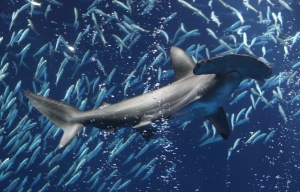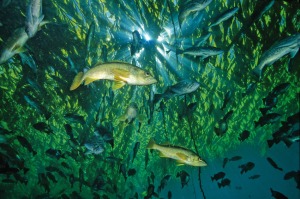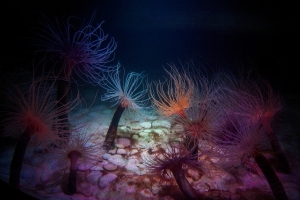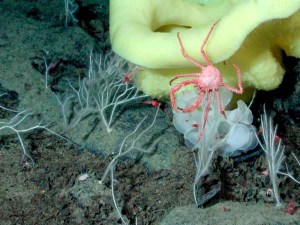Every living thing is constantly shedding fragments of itself into the environment. Police detectives take advantage of this at a crime scene when they search for hair, skin or saliva—all of which contain DNA, a full genome of information unique to their owner.
Fishes, sharks and other marine organisms shed their DNA, too. In every cup of seawater, there are sloughed-off cells and waste from the animals that have swum, drifted or floated there.
This DNA from the environment is called eDNA. Over the past few years, scientists at the Center for Ocean Solutions (COS)— a partnership among the Monterey Bay Aquarium, the Monterey Bay Aquarium Research Institute (MBARI) and Stanford University—have investigated how scientists, conservationists and resource managers can use eDNA to gain critical information about marine ecosystems, more quickly and more cheaply than ever before.
An Aquarium exhibit becomes a lab
Researchers first used environmental DNA in 2009 and 2010 to identify invasive Asian carp in the Great Lakes. Since then, scientists have used eDNA techniques on land and in freshwater to identify which species may be present in specific environments.

The COS researchers wanted to know whether eDNA methods would also work in the ocean. So they sampled water from the Aquarium’s Open Sea exhibit, which contains about 1.2 million gallons of seawater—and a host of different species.
“It was the biggest tank we could find,” says Ryan Kelly, a COS fellow at the time of the study, and the first author of the resulting paper, published in the academic journal PLoS ONE. “It was as close as we could get to the real world while still working in a controlled environment.”
Working at the Aquarium provided Ryan and his colleagues with a unique opportunity. Since they knew which species were kept in the Open Sea exhibit, they had an unprecedented chance to test how well eDNA methods might work in the ocean.
“It was one of the first times anyone actually tried to use environmental DNA to identify multiple species in a large tank,” says Jesse Port, one of Ryan’s collaborators and a COS fellow.

Ryan and Jesse tried to identify all the vertebrates in the exhibit just by looking for eDNA in the 1-liter water samples. They found genetic signatures from almost all of the exhibit’s fish—and even a few species that came in with the fish feed. But the sharks, rays and sea turtles were more difficult to identify.
The problem had to do with the primers the team used to identify species. Primers are like tiny barcode scanners, which identify sequences of DNA unique to a particular species. Jesse calls primers “the magic potion that makes eDNA methods work.”
The Aquarium test revealed that scientists would need primers more specific to sharks, rays and sea turtles to identify their DNA in the ocean environment.
Roll call in the open ocean
In the PLoS ONE study, the COS team verified that the right set of primers would likely allow them to “take attendance” of the marine animals in the Open Sea exhibit. However, they worried it would be harder in the open ocean, where tides and waves do a lot more mixing.

For eDNA methods to be useful, this mixing must be limited: DNA from animals in the kelp forest ideally would stay in the kelp forest, and not combine with DNA from animals far off the coast or deep in the Monterey Canyon. Environmental DNA methods run the risk of providing both false positives and false negatives. For example, DNA from a species that doesn’t live in a certain marine environment could show up in a sample—a false positive.
“We thought the water moving everywhere would move the DNA everywhere,” Ryan says.
To test whether eDNA methods could identify fish species in the wild, the COS researchers teamed up with scientists at Stanford University’s Hopkins Marine Station, which sits next door to the Aquarium. They took seawater samples in four different habitats just offshore.

The seagrass bed, sandy bottom, kelp forest and rocky reef habitats were located within about 30 feet one another, and they hosted very different species of fish. If eDNA methods could be useful, the team reasoned, they should be able to distinguish between species in these four habitats.
It turned out that water movement was not a problem. The eDNA tests showed that each of the four habitats contained different species. The researchers reported their findings in a paper published in December 2015 in the scientific journal Molecular Ecology.
“We were really excited to support the COS team’s work,” says Sue Lisin, the Aquarium’s senior coordinator of conservation research. “Environmental DNA provides an easy way to assess whether something rare is still around without having to go out looking for it.”
A powerful new tool
This genetic testing method has its limits. For example, eDNA can indicate that there are sardines in a certain area, but it can’t tell you how many sardines are present. But the research done both within the Aquarium and just offshore is encouraging.

“Right now, we do not have a sustainable method of describing animal communities,” says Francisco Chavez, a senior scientist and biological oceanographer at MBARI. “Environmental DNA will give us that.”
Future COS researchers will continue developing eDNA methods in collaboration with MBARI, Hopkins and the Aquarium as a tool for studying species composition, both near the coast and in the open ocean. In the meantime, researchers like Ryan and Jesse are working on making eDNA techniques more accessible to scientists, conservationists and managers.
Ultimately, these techniques will help produce data critical to managing marine protected areas, keeping fishing stocks healthy and monitoring the movements of species—especially in the face of climate change and other pressures. It can also be used to find rare and endangered species that traditional sampling methods don’t uncover.
“This isn’t pointy-headed science,” Ryan says. “I’m constantly blown away by the idea that you can get all of this information from a glass of seawater.”
-Diana LaScala-Gruenewald
Learn more about Conservation Research in which the Aquarium is involved.

this is the kind of science other aquariums should be doing.
LikeLike
Reblogged this on SURVIVAL SCIENCE.
LikeLike